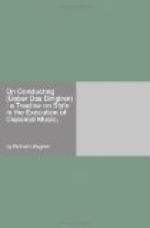APPENDIX B.
[See p. 62, et seq. of Wagner’s “Beethoven,” translated by E Dannreuther, London, 1882.]
“A Beethoven day:” Beethoven’s string quartet in C sharp minor. “If we rest content to recall the tone-poem to memory, an attempt at illustration such as the following may perhaps prove possible, at least up to a certain degree; whereas it would hardly be feasible during an actual performance. For, whilst listening to the work, we are bound to eschew any definite comparisons, being solely conscious of an immediate revelation from another world. Even then, however, the animation of the picture, in its several details, has to be left to the reader’s fancy, and an outline sketch must therefore suffice. The longer introductory Adagio, than which probably nothing more melancholy has been expressed in tones, I would designate as the awakening on the morn of a day that throughout its tardy course shall fulfil not a single desire: not one. [Footnote: “Den Tag zu sehen, der Mir in seinem Lauf Nicht einen Wunsch erfullen wird, nicht Einen.” Faust.] None the less it is a penitential prayer, a conference with God in the faith of the eternally good. The eye turned inwards here, too, sees the comforting phenomena it alone can perceive (Allegro 6/8), in which the longing becomes a sweet, tender, melancholy disport with itself; [footnote: Ein Wehmuthig holdes Spiel.] the inmost hidden dream-picture awakens as the loveliest reminiscence. And now, in the short transitional Allegro moderate it is as though the Master, conscious of his strength, puts himself in position to work his spells; with renewed power he now practises his magic (Andante 2/4), in banning a lovely figure, the witness of pure heavenly innocence, so that he may incessantly enrapture himself by its ever new and unheard of transformations, induced by the refraction of the rays of light he casts upon it. We may now (Presto 2/2) fancy him, profoundly happy from within, casting an inexpressibly serene glance upon the outer world; and, again, it stands before him as in the Pastoral Symphony. Everything is luminous, reflecting his inner happiness: It is as though he were listening to the very tones emitted by the phenomena, that move, aerial and again firm, in rhythmical dance before him. He contemplates Life, and appears to reflect how he is to play a dance for Life itself (Short Adagio 3/4); a short, but troubled meditation—as though he were diving into




